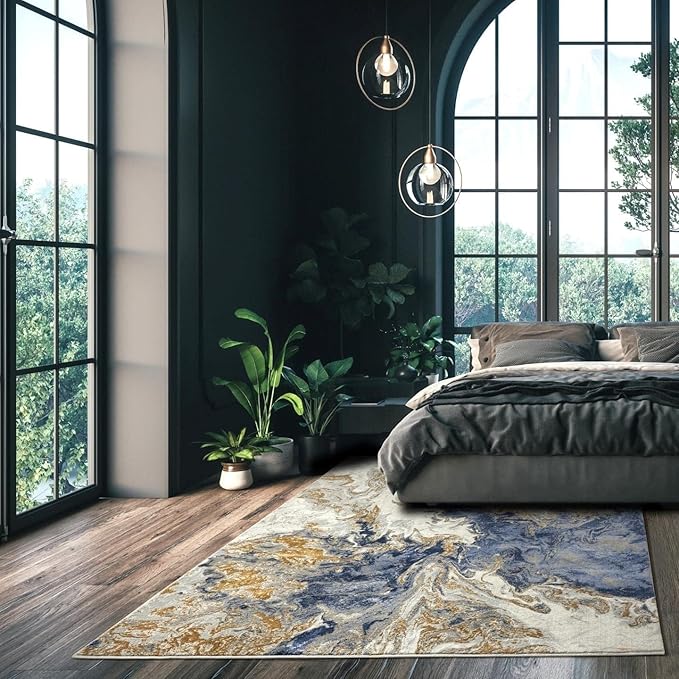
How to Select Ideal Carpet for Living Room?
The living room is often the heart of a home, where relaxing, entertainment and socializing take place. Therefore, it is important to choose a carpet that complements the design, meets practical needs and enhances comfort. The key factors to consider when choosing the right carpet for the living room include size, color, material and additional features that are often overlooked.
Importance of carpet size
The size of the carpet is a fundamental aspect that can make or break the look of a decorated home. A correctly sized carpet will define the seating area, creating a coherent and inviting atmosphere. Conversely, the wrong size carpet can make the space feel cluttered or cramped.

- Define the seating area: The carpet should surround the seating area, anchor the furniture and create a unified space. Extending the carpet down to the front legs of sofas and chairs is the ideal placement. This placement helps to visually ground the furniture and establish the boundaries of the seating area.
- Rule of thumb: When taking measurements for carpet, it is advisable to measure the seating area up to the front legs of all furniture. It is better to choose a carpet slightly larger than this measurement to ensure that the furniture does not overcrowd the space. The carpet should not touch the walls, leaving about 10 to 12 inches of space between the edge of the carpet and the walls for a balanced look.
Choosing the right carpet color and pattern
The color and pattern of the carpet play an important role in determining the overall mood and style of the living room. The carpet serves as the foundation of the room’s design, tying together various elements and creating visual harmony.
- Complements existing decor: When choosing a carpet color, consider the existing furniture and decor. For rooms with bold or patterned furniture, a neutral or solid-colored carpet can provide balance. Conversely, if the furniture is simple and doesn’t have a pattern, a patterned carpet can add interest and depth to the room.
- Matching secondary colors: It is often best to choose a carpet that features a secondary color found in the room’s decor, rather than the dominant color. This approach creates a cohesive look without overwhelming the space with a single color.
Carpet material
The carpet’s material is another important consideration, as it affects both the look and feel of the living room. Different materials offer different benefits and drawbacks, depending on the room’s traffic and use.
- Wool: Wool is a popular choice for its softness and durability. It’s naturally stain-resistant and water-repellent, making it suitable for high-traffic areas. However, wool carpets can be shed, which is minimized over time with regular vacuuming.
- Cotton: Cotton carpets are budget-friendly and easy to clean. They often come in flat weaves, which makes them less plush but still functional. However, cotton carpets may not last as well over time compared to other materials.
- Natural fibers: Carpets made from jute, sisal or other natural fibers are known for their durability. These materials are great for areas that are subject to wear and tear, although they can be rough and difficult to clean.
- Synthetics: Synthetic carpets, such as those made from nylon or polyester, mimic the appearance of natural fibers but are more budget-friendly and easier to maintain. They are especially family-friendly but may lack the luxurious feel of natural materials.
- Image suggestion: Side-by-side comparison of carpet samples in wool, cotton, natural fibers and synthetics to highlight differences in texture and appearance.
Considering the type of carpet pile
The type of pile, or the height and density of the carpet fibers, is another important factor that affects the look and durability of the carpet. The type of pile should be selected based on the use of the room and the level of comfort desired.
- Low pile: Low-pile carpets have shorter, denser fibers, making them more durable and easier to clean. They are ideal for high-traffic areas where strength is a must. Additionally, low-pile carpets are often more affordable.
- High pile: High-pile carpets, like a shag rug, have long, loose fibers that give a plush and comfortable feel underfoot. While they add comfort and luxury to the living room, they are less suitable for high-traffic areas because they are more difficult to clean and maintain.
Do not forget the carpet Pad
One component that is often overlooked, but which is important in choosing a carpet, is the carpet pad. The carpet pad offers several benefits that improve the longevity and comfort of the carpet.
- Impact and sound absorption: Carpet pad absorbs the impact of the floor, which reduces the wear and tear of the carpet and makes the floor feel softer. It also dampens sound, so it is especially useful in homes with hard floors.
- Floor protection: Carpet pad protect wooden floors from scratches and prevent the carpet from sliding, ensuring that it will stay in place even in high-traffic areas.
- Increased comfort: For carpets placed on hard surfaces such as tile or wood, the carpet base adds another layer of moisture absorption, which improves the general comfort of the living room.



